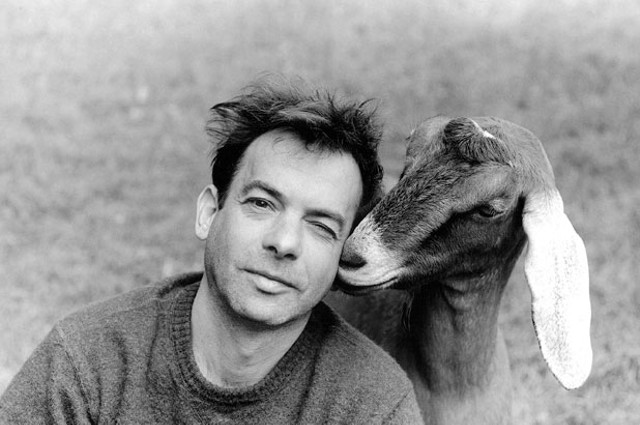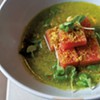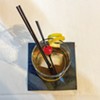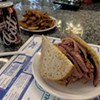Published September 9, 2009 at 5:01 a.m.
If you arrive at Brad Kessler’s southern Vermont farmhouse and don’t find him at home, he’s probably out walking the goats. In clement weather, the slender 46-year-old ambles up a hill and through an aging orchard with his herd of nine Nubians, stopping for a moment to pluck small green apples. The copper and black goats, the largest of which weigh in at around 150 pounds, thrust their elegant necks toward him in anticipation of the treat. Deeper in the woods, after singing out their names in a yodeling warble — Hannah, Nisa, Pie — he bends saplings toward the loam so the beasts can nibble on their verdant leaves.
As naturally as Kessler communes with his animals on their daily “goat walk,” he wasn’t to the barnyard born. The award-winning novelist grew up in New York’s Westchester County and, after college, moved into the city to work in publishing. But a decade ago, he and his wife, photographer Dona Ann McAdams, gave up their rent-controlled apartment in the East Village and moved to a 75-acre parcel in Sandgate, Vt., a town of fewer than 500 nestled in a valley shadowed by the craggy Taconic Mountains.
The patch of rural beauty seems like a perfect place for an artist to hone his craft. In 2006, Kessler published the much-lauded novel Birds in Fall, in which he intertwined ornithological lore with a plane crash. Last year he received a prestigious writing grant that took him and McAdams to an artists’ colony in Italy. But nothing changed their lives as thoroughly as the decision that gave rise to Kessler’s new book: In 2005, they acquired Hannah and Lizzie, their first pair of goats, and began making cheese.
Kessler’s newest tome — a lush and affecting memoir entitled Goat Song: A Seasonal Life, a Short History of Herding, and the Art of Making Cheese — tells how he and McAdams learned to milk, breed and care for their flock in good times and bad, and the lessons they’ve learned in the process. Reporters at the Boston Globe, the Los Angeles Times and Salon.com variously praised the book as “rich” and “mouth-watering.”
Goat Song is not your typical city-slicker-meets-goat narrative. With lyrical, expressive prose, Kessler loads the book with fascinating snippets on the history of herding, lines from pastoral poems and etymologies of cattle-related terms. Plus, as a farming outsider, he is able to clearly portray agriculture’s beauty and its brutality.
Unlike some modern memoirists — such as the woman who cooked every recipe in Julia Child’s Mastering the Art of French Cooking — Kessler and McAdams moved to the country as a considered lifestyle choice, not a wacky artistic project. Kessler says he never felt completely at ease with city life. He writes in Goat Song: “My whole life it seemed I’d been searching for a retreat in the mountains, a patch of land where I could grow my own food.”
Although cheese wasn’t of much interest to him until he began making his own, cultivating and preparing food had long been a passion of Kessler’s. “My mother will kill me if she sees this, but [she] was not a good cook,” he admits. Along with his siblings, including an older brother who is now a baker, Kessler “started cooking as survival.” Although he doesn’t recall having any particular specialties in the kitchen, he liked the idea of gleaning the great outdoors: “I remember experimenting with wild edibles when I was in high school,” he says. But living in the ’burbs, where “daylily bulbs were about the only [wild food available],” threw a wrench in his early experimentation.
Kessler read and loved Thoreau in his youth, but his quest for a rural existence was spurred by firsthand experiences, too. One summer while visiting his brother in West Virginia, Kessler spent a day haying. “We worked until evening and salt burned our faces, but I recall a joy I’d never experienced before, as if I’d found some calling or communion I hadn’t known existed,” he writes in Goat Song.
Sitting at the rustic wooden table in his home, a cup of black tea blanched with fresh, raw goat milk in hand, Kessler goes on: “Visiting him, I saw how you could have an intellectual life and also live in the country and grow your own food, and it didn’t have to be isolating.”
Particularly not when the Big Apple is just four hours away. Kessler recalls visiting the city a few years ago for a snazzy party at which he met Erica Jong, then rushing home in time for morning milking. When he and McAdams first moved to Vermont, so many people came to visit that “we began to feel like we were running an inn,” he jests.
Rural life suits Kessler so well that he was reluctant to accept a John Guare Writer’s Fund Rome Prize, which comes with a year’s stay at the American Academy in Rome. “I didn’t apply for it,” he notes, walking past a table covered with green tomatoes saved from plants ravaged by late blight.
“I like it here,” he says with a wave of his hand. His gesture encompasses the sprawling farmhouse with its foyer where whole corn stalks and bunched garlic bulbs dry in the rafters; the lush green fields dotted with flowers; and the expressive herd of goats, which begin braying whenever Kessler steps onto the lawn.
McAdams eventually prevailed on Kessler to accept the tickets to Rome, but, so as not to miss the breeding and the kidding of the goats, the couple opted to stay for seven months instead of the typical 12. In their absence, house sitters cared for the animals and for Kessler’s cheeses, which he ages in a cool basement cellar lined with wooden shelves.
Despite his initial resistance, Kessler is glad he spent time in Europe. It was there he finished penning his memoir. The goats and cheeses survived the couple’s absence — “We were lucky,” he says dryly. And he delighted in the food served at the Roman villa, prepared by chefs and interns from Chez Panisse in Berkeley. In Italy, he notes, “You eat what’s in season and you eat what’s in your backyard.” Kessler appreciates the Italian food philosophy, but that didn’t stop him from smuggling prosciutto and heirloom seeds through customs when he returned to the States in April.
“Trade is not a bad thing,” he says. “Tea, olive oil, salt: We can’t get those things here.”
The best of both worlds: Kessler and McAdams have that in Sandgate, too. They experience the pastoral pleasures of living on a remote piece of land suitable for goatherding, but maintain “day jobs” that depend on technology such as email and the Internet. In addition to his longer works, Kessler has written a slew of children’s books and published in prestigious magazines such as the New Yorker.
Kessler is clearly no Luddite, but he firmly believes everyone can benefit from relationships with working animals. “Get to know a farmer, get to know somebody who raises animals, get to know an animal,” he suggests. “Once you form a relationship with an animal that feeds you, it kind of changes your perspective, and this whole world opens.” The word tragedy, Kessler notes in his book, comes from the Greek term for a goat’s cry, tragõidia. Although it’s not what the ancients meant, he implies that lacking an intimate connection with the natural world — and its denizens — may be one of the tragedies of modern life.
But caring for a herd has its tribulations. Throughout the book, Kessler’s joy is tempered by difficulties. For example, he and McAdams learn that Hannah, their goat queen, is temperamental and difficult to milk: “My arms began to cramp; I broke into a sweat. Hannah slammed the pail with her foot. Milk flew everywhere — the pail crashed to the floor.”
In the most heartrending segment, Lizzie, the other of the couple’s original two goats, is taken ill. “I ran into the paddock and sprinted up the hill, shouting her name over and over, terrified of where she might be,” Kessler writes. “I reached the top and flew across the flat. A harrowing howl came from the corner of the pasture. Lizzie stood against the fence, screaming. I called but she didn’t turn to face me.”
And, despite the undeniable goat-human bond, Kessler confesses there’s a harshness to dairying he didn’t consider until he was the one doing the milking. “Dairying is a kind of violence. Even here in the best of circumstances,” he writes. “To get milk from our goats we create a state of enforced nursing. We impregnate our does, steal their babies, and sell them to strangers.” Later, Kessler points out that anybody who drinks milk, meat eater or not, contributes to the death of animals. “It’s the bacon-eating urbanites who hate hunters that drive me crazy,” he notes.
Soon enough, though, city dwellers may have access to Kessler’s cheese. Since he’s had a larger herd, most of which will be milked in 2010, he’s worked with the Vermont Department of Agriculture to certify his cheesemaking operation. This means Kessler can sell his aged tommes to an interested New York restaurant, Les Enfants Terribles. With rinds mottled from growth after growth of “good” bacteria and colorful mold blooms, his oldest wheels are dry and complex, with nutty and even mushroomy notes. While Kessler says that “what we have is very limited,” he also plans to send some down the road to the restaurant at the Inn at West View Farm.
No matter how good it is, nobody will be able to buy Kessler’s fresh chèvre, the cheese that convinced him he needed his own herd of goats. Although raw milk may be sold legally in Vermont, raw milk cheeses aged fewer than 60 days may not. But when he has visitors, the writer is willing to share his cheese alongside homemade pickles, sauerkraut, his brother’s artisan breads and smuggled Italian prosciutto. The fresh chèvre, rolled in savory or chives, has a delicate herbal flavor that can only be found in the raw milk of animals raised on pasture.
Until the law changes, readers will have to content themselves with Kessler’s lush description of the product of his labors: “It tasted like nothing we’d ever eaten before — a custard, a creamy pudding, the cheese so young and floral it held within its curd the taste of grass and herbs the goat had eaten the day before. It seemed we were not eating a cheese, but a meadow.”
Want to learn more?
Brad Kessler reads at the Burlington Book Festival on Saturday, September 26, 1-2 p.m., in the Film House, Main Street Landing Performing Arts Center, in Burlington. Free.
Taste It
Kessler’s memoir offers some memorably vivid descriptions of food and the outdoors. Here’s a sampling:
In the kitchen the water bath had cooled. I removed the lid from the pot. The odor inside was pleasant and sweet like custard, with a hint of vanilla. The curds lay submerged beneath an inch of clear whey. The whey had a slightly greenish tint, as if the curds were sunk in seawater.
Lizzie’s been waiting patiently the whole time. She leaps up next. Her body smells of hair and hide and something slightly oily but not unpleasant. I lean my forehead on her orange flanks and she leans back; and after a few seconds, I feel her milk let down. Small explosions rumble in her stomach, her rumen contracting every sixty-three seconds. Beside my ear, her body sounds like the ocean.
In spring we ate chèvre with wilted watercress or dandelion greens, or a dollop on top of fried eggs and asparagus. In summer we ate chèvre on grilled eggplant and zucchini, in pasta, or with black beans, salsa, and chips. We ate faisselle [unaged goat cheese] with woodland berries soaked in maple syrup, or with peach slices when they came into season.
From Goat Song: A Seasonal Life, a Short History of Herding, and the Art of Making Cheese. Scribner, 239 pages. $24.
More By This Author
Speaking of...
-

Middlebury's Champlain Valley Creamery Marks 20 Years With a Milestone Cheese
Feb 27, 2024 -

Q&A: Howard Fisher Delivers Meals on Wheels With a Side of Good Cheer
Dec 20, 2023 -

Video: Howard Fisher Delivers Meals on Wheels
Dec 14, 2023 -

Q&A: Alexis Dexter Rescued 57 Shelter Cats During the July Flood
Sep 13, 2023 -

Video: Two Months After the Flood, Alexis Dexter Rebuilds Kitty Korner Café in Barre and Continues to Rescue Cats
Sep 7, 2023 - More »
Comments
Comments are closed.
From 2014-2020, Seven Days allowed readers to comment on all stories posted on our website. While we've appreciated the suggestions and insights, right now Seven Days is prioritizing our core mission — producing high-quality, responsible local journalism — over moderating online debates between readers.
To criticize, correct or praise our reporting, please send us a letter to the editor or send us a tip. We’ll check it out and report the results.
Online comments may return when we have better tech tools for managing them. Thanks for reading.













































